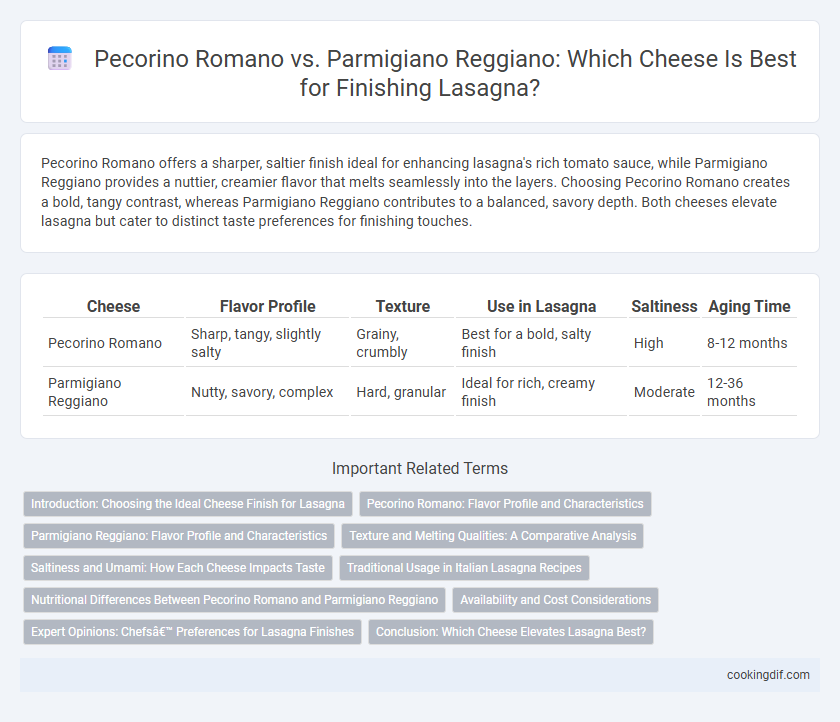Pecorino Romano offers a sharper, saltier finish ideal for enhancing lasagna's rich tomato sauce, while Parmigiano Reggiano provides a nuttier, creamier flavor that melts seamlessly into the layers. Choosing Pecorino Romano creates a bold, tangy contrast, whereas Parmigiano Reggiano contributes to a balanced, savory depth. Both cheeses elevate lasagna but cater to distinct taste preferences for finishing touches.
Table of Comparison
| Cheese | Flavor Profile | Texture | Use in Lasagna | Saltiness | Aging Time |
|---|---|---|---|---|---|
| Pecorino Romano | Sharp, tangy, slightly salty | Grainy, crumbly | Best for a bold, salty finish | High | 8-12 months |
| Parmigiano Reggiano | Nutty, savory, complex | Hard, granular | Ideal for rich, creamy finish | Moderate | 12-36 months |
Introduction: Choosing the Ideal Cheese Finish for Lasagna
Pecorino Romano offers a sharper, saltier finish that enhances the rich tomato and meat flavors in lasagna, while Parmigiano Reggiano provides a nuttier, more complex profile with subtle sweetness and umami depth. Both cheeses are aged, but Pecorino Romano's sheep's milk base lends a tangier bite compared to the cow's milk richness of Parmigiano Reggiano. Selecting Pecorino Romano intensifies savory notes, whereas Parmigiano Reggiano rounds out the dish with a balanced, creamy finish.
Pecorino Romano: Flavor Profile and Characteristics
Pecorino Romano offers a sharp, tangy flavor with salty and nutty undertones, making it ideal for finishing lasagna with a bold punch. Its hard, crumbly texture allows for easy grating, enhancing the dish without overpowering other ingredients. Compared to Parmigiano Reggiano, Pecorino Romano provides a more pronounced saltiness and a robust, slightly piquant profile that accentuates traditional Italian flavors.
Parmigiano Reggiano: Flavor Profile and Characteristics
Parmigiano Reggiano offers a complex flavor profile with nutty, savory, and slightly fruity notes, making it ideal for finishing classic lasagna dishes. Its granular texture and rich umami enhance the layers of pasta, meat, and bechamel, creating a harmonious and deeply satisfying taste experience. Unlike Pecorino Romano, Parmigiano Reggiano provides a milder, less salty finish that complements without overpowering other ingredients.
Texture and Melting Qualities: A Comparative Analysis
Pecorino Romano offers a firmer texture and sharp, salty bite that enhances lasagna's finishing layer without fully melting, creating a slightly granular contrast. Parmigiano Reggiano melts more smoothly with a creamy, nutty profile, providing a cohesive, velvety finish that integrates seamlessly into the sauce. Choosing between the two affects lasagna's mouthfeel: Pecorino Romano adds a robust, textured crispness while Parmigiano Reggiano delivers a rich, silky melt.
Saltiness and Umami: How Each Cheese Impacts Taste
Pecorino Romano delivers a sharper saltiness and a more pronounced umami punch, enhancing the savory depth of lasagna with its bold, tangy flavor. Parmigiano Reggiano offers a balanced saltiness combined with a nutty, complex umami profile that adds a subtle richness without overpowering other ingredients. Choosing between the two cheeses allows for tailoring the final taste--Pecorino for a robust, salty finish, and Parmigiano for a nuanced, creamy enhancement.
Traditional Usage in Italian Lasagna Recipes
Pecorino Romano is traditionally used in Italian lasagna recipes from central and southern regions, valued for its sharp, salty flavor that enhances the rich tomato sauce and layers of meat. Parmigiano Reggiano, preferred in northern Italy, offers a nuttier, milder taste that complements bechamel sauce and delicate pasta sheets. The choice between Pecorino Romano and Parmigiano Reggiano depends on regional preferences and the specific balance of flavors in the lasagna.
Nutritional Differences Between Pecorino Romano and Parmigiano Reggiano
Pecorino Romano contains higher sodium levels than Parmigiano Reggiano, making it a more intense seasoning option for lasagna finishing. Parmigiano Reggiano offers a richer source of calcium and protein, supporting bone health and muscle maintenance. Both cheeses provide essential nutrients, but choosing depends on dietary needs related to sodium intake and nutrient density.
Availability and Cost Considerations
Pecorino Romano tends to be more affordable and widely available in Italian markets, offering a sharper and saltier finish for lasagna dishes. Parmigiano Reggiano, while often pricier due to its lengthy aging process and protected designation of origin, brings a nuttier and more complex flavor profile that enhances lasagna with a rich, umami depth. Cost-conscious cooks might prefer Pecorino Romano for everyday use, whereas Parmigiano Reggiano is reserved for special occasions or gourmet-quality lasagna.
Expert Opinions: Chefs’ Preferences for Lasagna Finishes
Chefs favor Pecorino Romano for lasagna finishing due to its sharp, salty profile that enhances tomato-based sauces and cuts through rich bechamel layers. Parmigiano Reggiano is preferred for its nutty, complex flavors that add depth and a smooth, creamy finish, balancing meat and cheese components. Expert consensus highlights Pecorino's intensity for bold dishes, while Parmigiano offers a subtle, sophisticated complement, influencing regional lasagna variations.
Conclusion: Which Cheese Elevates Lasagna Best?
Pecorino Romano adds a sharp, salty punch and a bold, tangy flavor that complements rich tomato sauces and hearty meat layers in lasagna, enhancing its savory depth. Parmigiano Reggiano offers a nutty, complex profile with a creamy texture that melts beautifully, providing a balanced and refined finish to the dish. Choosing Parmigiano Reggiano generally elevates lasagna best due to its versatility and subtlety, allowing the dish's layers to shine without overpowering the overall flavor.
Pecorino Romano vs Parmigiano Reggiano for finishing Infographic

 cookingdif.com
cookingdif.com